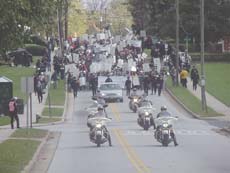A helicopter hovered above police, solemnly watching hundreds of people rejoicing in song, marching through Greensboro and remembering those lost in the Greensboro Massacre of 1979. On Nov. 13, 2004, an estimated 700 people gathered to finish a march that went unfinished on Nov.3, 1979 when Nazi and Klan members impeded upon a legally scheduled peaceful march. TV crews captured members of the Klan and Nazi Party, killing five people and injuring ten others. Marchers consisted of individuals from the Communist Workers Party, who themed the event “Death to the Klan.” The shooters were acquitted in court regardless of the taped evidence.
Those commemorating the 25th anniversary of the massacre met on the corner of Everitt and Dunbar at 10 a.m. to rally and began marching at 11:23 a.m. The march continued to Phil G. McDonald Plaza.
Many marchers carried signs reading “From Tragedy to Triumph” above their heads as they marched. Others brought homemade signs, emphasizing importance of justice and the power to “rise up.” A projected 200 of the marchers were Guilford students and alumni. Roughly 250 police attended the march, making no arrests.
The Greensboro Truth & Reconciliation Project (GTCRP) has been working to restore justice to the 1979 events. Such efforts included the march that took place on Nov.13 2004.
The march paused at Bennett College, as a woman standing on a trailer clutched a microphone leading everyone to reflect on the death of a Bennett College sister, Sandi Smith. Smith was killed during the Nov.3 march. The music then picked up, inviting the marchers to clap and join in with the optimistic songs that followed.
The 2004 marchers included people of all ages and races, some who lived through the massacre and others who were not yet born. Many marchers dressed their children for the cold weather and brought them along. One man held a sign that displayed his role as a liberal grandparent.
An unknownGreensboro police officer, who was on duty at both marches, spoke on the difference between the two. Though reluctant to share his opinions, he said that the march in 1979 was: “Very, very confusing; there were groups trying to polarize the black community. We were here, same as today, to protect first amendment rights.”
The officer said, of the march of 1979: “We were dealing with armed groups and hate groups. We were dealing with two radical elements.”
Art Hollis, a Greensboro Police officer, on duty at the 2004 march said, “The march was great. It is a good purpose.”
As people gathered post march, speakers shared views on the importance of the event. One speaker said, “We have an obligation to never stop struggling for freedom and justice.” Next, a musician took the stage to play Bob Marley’s “Redemption Song” while many sang along.
Junior Liz Welton, who worked with other Guilford students directly involved in the GTRCP said: “I felt like a baton was being passed down to our generation that gave us a much needed sense of hope and power. The march seemed awaken a collective sense of empowerment.”
Senior, Liz Nemitz said: “The whole day was amazing. There was one part at the rally when Marty Nathan (one of the widows and survivors) was up on stage with all of the survivors and their families, and she just bellowed out, ‘Today we finished the march that we started on November 3, 1979!’ I had the honor of introducing her. The whole crowd went nuts, and it gave me chills. I just hope that everyone realizes what a huge deal this was, and that they can feel privileged to have been a part of it.”

